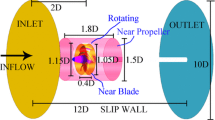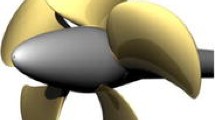Abstract
This paper deals with numerical simulations of the cavitating flow around two highly skewed propellers operating in open water and mounted on an inclined shaft. The aim of the study is to check the ability of our numerical method in distinguishing the variation in flow features resulting from different blade designs. Moreover, a secondary aim is also to improve the knowledge about the physics that control the growth and collapse of cavitation, and hence also the generation of cavitation noise and erosion on this type of propellers. The investigation is based on incompressible large eddy simulation (LES) in combination with a volume-of-fluid implementation to represent the two phases of liquid and vapour, and a transport equation-based method for the mass transfer between the phases. High-speed video recordings from experiments were made available for comparison. The simulations demonstrate that the current method makes it possible to analyse the main difference in flow features caused by modest design alternation. Furthermore, with suitable grid resolution, LES is demonstrated to be capable of capturing the mechanisms that are important in the cavitation development, and that numerical simulation is a reliable supplement to experiments in advanced propeller design.












Similar content being viewed by others
References
Hämäläinen R, Lönnberg B, Arén P, Pettersson G (2005) Highest Comfort Class design for ‘M/S Color Fantasy’, the world’s largest ever cruise-liner with car-deck. In: 1st international ship noise & vibration conference, London, UK
Bensow RE, Bark G (2010) Implicit LES prediction of the cavitating flow on a propeller. J Fluids Eng 132(4):1–10
Lu N-X, Bensow RE, Bark G (2010) LES of unsteady cavitation on the delft twisted foil. J Hydrodyn 22(5) supplement: 784–791
Lu N-X, Bensow RE, Bark G (2011) Indicators of erosive cavitation in numerical simulations. In: The 7th international workshop on ship hydrodynamics, Shanghai, China
Salvatore F, Streckwall H, Terwisga T (2009) Propeller cavitation modelling by CFD—results from the VIRTUE 2008 rome workshop. In: Proceeding of 1st international symposium on marine propulsors – smp’09, June 2009, Trondheim, Norway
Proceedings of the workshop on cavitation and propeller performance. In: Second international symposium on marine propulsors-smp’11, 17–18 June 2011, Hamburg, Germany
Lu N-X, Svennberg U, Bark G, Bensow RE (2012) Numerical simulations of the cavitating flow on a marine propeller. In: Proceeding of the 8th international symposium on cavitation, Singapore
Sagaut P (2006) Large eddy simulation for incompressible flows, 3rd edn. Springer, Berlin
Hirt C (1968) Heuristic stability theory for finite difference equations. J Comp Phys 2:339
Fureby C, Grinstein FF (1999) Monotonically integrated large eddy simulation of free shear flows. AIAA J 37(5):544
Grinstein FF, Margolin L, Rider W (2005) Implicit large eddy simulation: computing turbulent fluid dynamics. Cambridge University Press, Cambridge
Bensow RE, Liefvendahl M (2008) Implicit and explicit subgrid modeling in LES applied to a marine propeller. In: The 38th AIAA fluid dynamics conference and exhibit, art. no. 2008-4144
Bensow RE (2011) Capturing secondary cavitation—a step towards numerical assessment of cavitation nuisance. Ship Technol Res 58(2):70–81
Lu N-X (2010) Large eddy simulation of cavitating flows on hydrofoils. Licentiate Thesis, Chalmers University of Technology, Gothenburg, Sweden
Spalding DB (1961) A single formula for the law of the wall. J Appl Mech T ASME 28:455–457
Fureby C, Alin N, Wikström N, Menson S, Persson L, Svanstedt N (2004) Large eddy simulations of high-Reynolds-number wall-bounded flows. AIAA J 42:457–468
Hirt CW, Nichols BD (1981) Volume of fluid (VOF) method for the dynamics of free boundaries. J Comput Phys 39(1):201–225
Kunz R, Boger F, Stinebring DR, Chyczewski TS, Lindau JW, Gibeling HJ, Venkateswaran S, Govindan TR (2000) A preconditioned Navier-Stokes method for two-phase flows with application to cavitation. Comput Fluids 29(8):849–875
Huuva T (2008) Large eddy simulation of cavitating and non-cavitating flows. PhD Thesis, Chalmers, Sweden
Weller H, Tabor G, Jasak H, Fureby C (1998) A tensorial approach to computational continuum mechanics using object-oriented techniques. Comput Phys 12:620–631
Jasak H (1996) Error analysis and estimation for the finite volume method with applications to fluid flow. PhD Thesis, Imperial College, United Kingdom
Issa RI (1986) Solution of the implicitly discretised fluid flow equations by operator splitting. J Comput Phys 62:40–65
Rhie CM, Chow WL (1983) Numerical study of the turbulent flow past an airfoil with trailing edge separation. AIAA J 21:1525–1532
Bark G, Bensow RE (2012) Hydrodynamic mechanisms controlling cavitation erosion. In: Proceedings of 29th symposium on naval hydrodynamics, Gothenburg, Sweden
Tian Y, Kinnas S (2011) Modeling of leading edge vortex and its effects on propeller performance. In: The 2nd international symposium on marine propulsors, smp’11 Hamburg, Germany
Coutier-Delgosha O, Devillers J-F, Pichon T, Vabre A (2006) Endoscopic investigation of the internal structures of sheet cavitation. In: The 6th international symposium on cavitation, Wageningen, The Netherlands
Grekula M, Bark G (2009) Analysis of high-speed video data for assessment of the risk of cavitation erosion. In: The 1st international conference on advanced model measurement technology for the EU maritime industry (AMT’09), Nantes, France
Acknowledgments
Financial support is provided by Rolls Royce Marine through the University Technology Centre at the department of Shipping and Marine Technology, Chalmers. Experimental data is provided by Rolls-Royce Hydrodynamics Research Centre in Kristinehamn, Sweden. Computations are performed on Chalmers Centre for Computational Science and Engineering (C3SE) computing resources.
Author information
Authors and Affiliations
Corresponding author
About this article
Cite this article
Lu, NX., Bensow, R.E. & Bark, G. Large eddy simulation of cavitation development on highly skewed propellers. J Mar Sci Technol 19, 197–214 (2014). https://doi.org/10.1007/s00773-013-0240-3
Received:
Accepted:
Published:
Issue Date:
DOI: https://doi.org/10.1007/s00773-013-0240-3




